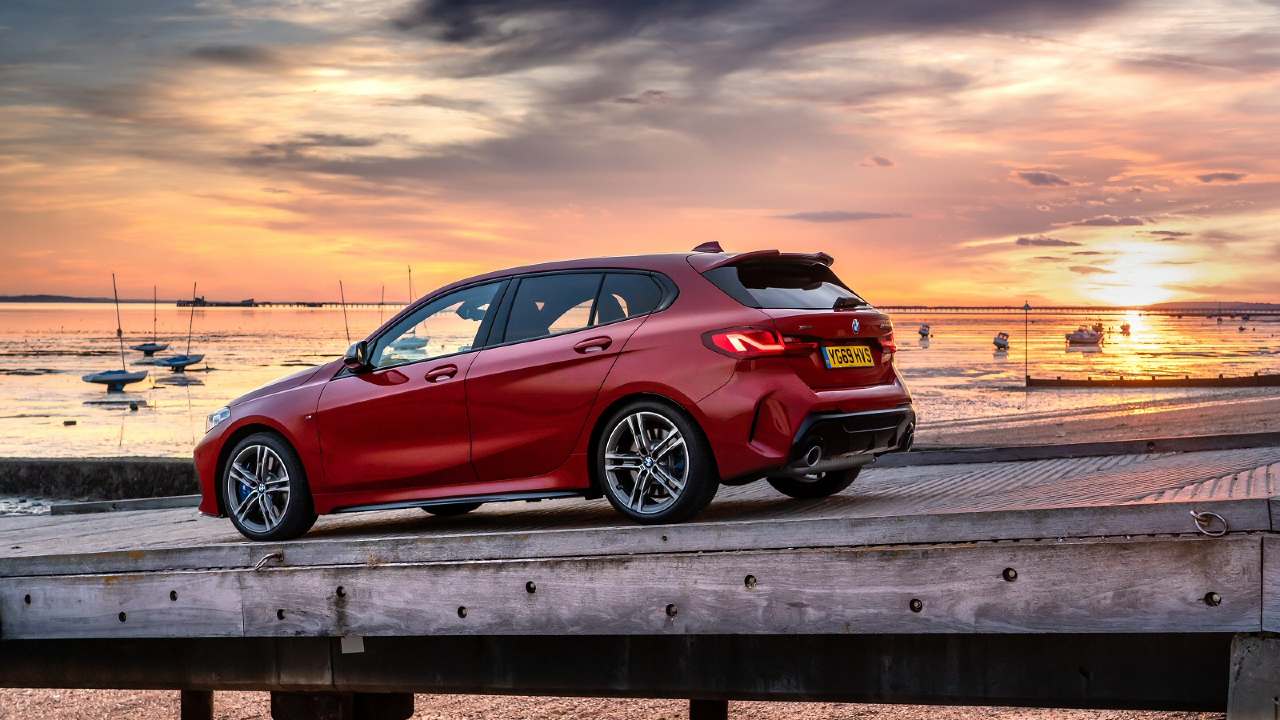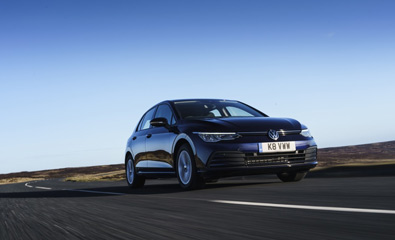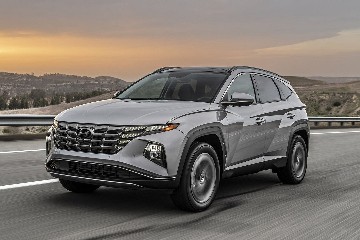By Mark Nichol
It’s the most cost-effective way of getting that blue and white roundel on your bonnet, although to frame the BMW 1 Series as the “the budget BMW” is to do it a massive disservice. This is the third version of a model that’s courted its own sort of storm-in-a-teacup controversy since 2004. The first 1 Series not only came late to the premium family hatchback game (both Audi and Mercedes-Benz debuted their premium runabouts in the 1990s) but it was divisively styled, with an aesthetic that BMW called “flame surfaced” but which manifested as a stumpy ‘breadvan’ profile and an oddly saggy tummy.
2011’s 1 Series Mk 2 was fairly conventional looks wise but when BMW replaced it with this one in 2019, drive shifted from the rear axle to the front, to the disdain of people on forums who care about that sort of thing. “But what about the handling?” was the cry. And while that’s definitely a legitimate concern, as is the view that this 1 Series has also been hit with an ugly stick, the fact is that the shift has made it much better at being a family hatchback. Which is obviously good.
What’s Good About It?
The thing we just said, mainly, that the 1 Series is now better at being a family runabout than it’s ever been. That’s in large part owing to the switch to front-wheel drive, which frees up space in the back because you don’t need a big driveshaft running the length of the cabin. The engines have also been turned 90 degrees (they’re transverse now) which means the bonnet doesn’t need to be as long. The result is a 20mm shorter wheelbase than before yet 30mm more rear legroom. It’s a little taller too, which partly explains why it looks a less ground-hugging than the previous two iterations. But, again, gives it more space.
It drives fantastically too…to a point. It’s true that some of the old car’s rear-wheel drive fluidity and balance has been lost, but BMW has engineered a lovely sense of sharpness and heft into the experience – or so it feels initially, at least, which we’ll come to. We’d also suggest that of all three German family hatchbacks (including the Mercedes-Benz A-Class and the Audi A3) this has the most user-friendly cabin. It’s less reliant on screens than the other two, which means it lacks their wow factor but it’s a lot more intuitive to operate thanks to shortcut buttons, physical temperature and volume controls, and BMW’s by-now well-honed iDrive rotary dial infotainment system.
What Could Be Better?
The most popular versions of any BMW you care to name are M Sport models, mainly because they look better with their sporty body styling, unique wheels, additional equipment and links to BMW’s famous Motorsport Division. That’s true of this 1 Series, but the combination of bigger wheels, thinner tyres and ‘sport’ suspension means the ride quality is set up on the firm side. It’s up to you whether you can live with that, but there’s no doubt that a 1 Series in Sport or SE spec is a more comfortable one.
And while this 1 Series is bigger in the cabin and the boot than before, it’s certainly not the most capacious family hatchback on the market. Set the front chairs back for someone 6ft or over, and adults of the same size will struggle for legroom in the rear. If space and comfort are more important to you than driving dynamics, the 1 Series probably isn’t going to be for you.
What’s It Like To Drive?
There’s no denying that the switch to front-wheel drive has compromised the 1 Series dynamically as compared to its predecessors, but still, nothing this side of the class-leading Ford Focus (a car we’re sure that BMW’s engineers spent some time with while developing this) feels as sharp as the 1 Series. Initially, at least. It feels connected, it tells you vociferously what’s happening under the wheels, and it has a more natural weight to the steering than most hatchbacks. There’s no doubt that if you test drive all three of the Germans together you’ll immediately feel that this is the one for “drivers”.
On paper, this should be the stickiest front-wheel hatchback ever made, and at first, it does feel that way. Every 1 Series has a torque distribution system that apportions it across the front axle, as well as a brake-based system called BMW Performance Control that nips the inside front brake when turning. They all have fancy multilink rear suspension too, when a lot of cars – the Volkswagen Group stuff, for example – have a simpler set up in the lower powered models. However, if the road’s damp or you’re just a bit ham fisted with your steering, it’s surprising how quickly the 1 Series can lose grip take a non-turn into understeer town. Nothing alarming, obviously, but there’s no doubt that this has lost some of the innate balance, of fluidity, that the outgoing (rear-wheel drive) car had.
The engine range looks surprisingly heavy on diesel in a market that’s generally dropping the derv, but in BMW’s case its diesel engines are brilliant so that’s no bad thing. Fast stuff aside you’re looking at a three-cylinder petrol and three-diesels. The 116d is a three-cylinder 1.5-litre, while the 118d and 120d are 2.0-litre four-cylinder units, the latter available with four-wheel drive, called xDrive. The 20d is a peach of an engine: quick, not too grumbly, 50mpg. In fact, all the diesels have that sense of being above average in the smoothness stakes.
But the basic 18i petrol engine is the best one, pound-for-pound. Like the driving experience itself, you could argue it flatters to deceive, in that it sounds great, much throatier than it was in the outgoing 1 Series, and it has a nice initial kick that makes it feel quick. However, if you’re driving more briskly it does seem to take quite a while to reach the redline. But, really, that’s less important than the fact that in calm, typical family hatchback conditions the 18i engine is really quiet and vibration-free.
Paired with the seven-speed twin-clutch automatic gearbox the 118i is pound for pound one of the very best drivetrains on sale. The shifts are super quick and inappreciable, and the throttle is responsive without being over-sensitive. It’s just a pure press-and-go experience, while also being characterful and fun.
How Practical Is It?
On paper, things look good for the 1 series, in that it offers a little more legroom from a slightly shorter wheelbase than the outgoing car, as well as a boot up by 20 litres, now 380 litres and stretching to 1200. It’s 12mm taller too, making it all about on par with the Volkswagen Golf and SEAT Leon. However, the 1 Series is definitely one of the more cramped family hatchbacks on sale, and some taller adults (or teenagers) will struggle in the back for legroom and shoulder room if the front seats are set a little way back.
That said, the 1 Series is ergonomically fantastic for a driver of any shape or size. There’s loads of seat and wheel adjustment, plenty of space around the driver and yet a feeling of being ‘sat down’ into the car. That thing that makes a car feel ‘sporty’, in other words. There’s a decent amount of cabin storage up front too, including a fairly deep centre console storage box including a USB-C port, a slot for a mobile phone in front of the cupholders, and door pockets shaped for a bottle. The boot is usefully thoughtful too, including a rear bench that split-folds properly flat and underfloor storage as standard – the upper floor section lifts up in two parts.
How Much Will It Cost Me?
Not as much as you think. Strong desirability and residuals make for very reasonable leasing prices, with a 118i M Sport available for well under £300. If you can live with the ride quality, that’s a great looking, economical and brilliant to drive family hatchback for not a great deal per month.
Running costs are appealing across the board, too. Leaving aside the 128ti and the M135i, all versions should surpass 40mpg in day-to-day driving. The 118i is best if you’re not doing many long journeys. It’s WLTP average rating is 49.6mpg, while the 1.5-litre 3cylinder diesel trades some of the smoothness of the 2.0-litre unit in the 118d and 120d for 61.4mpg economy. Getting a 120d with xDrive four-wheel drive will give you the quickest (and grippiest) 1 Series this side of the M Division versions, but fuel economy suffers notably, rated at 53.3mpg.
Anything Else I Should Know?
Although your heart will be telling you to get an M Sport model, even a basic 1 Series is well specified, coming with air conditioning, a nine-inch touchscreen, navigation, LED headlights, parking sensors all round, cruise control and, significantly, 16-inch wheels on relatively thick tyres. That’ll sort out the firm ride quality, if you can live with the reduced visual girth. Euro NCAP gave the 1 Series a five-star safety rating in 2019.
What Alternatives Should I Look At?
Mercedes A-Class Leasing
A more futuristic cabin, lighter steering, more interior space and a softer ride. Doesn’t have the 1 Series’s driver appeal though.
Audi A3 Leasing
An even more futuristic cabin and runs the BMW close for driver thrills. And let’s face it, the A3 is easier to look at too.
BMW X2 Leasing
A 1 Series raised slightly, simply put, the X2 will scratch your BMW hatchback itch while giving you a lot more interior space.
Vanarama Verdict: 8/10
"It’s the most cost-effective way to drive a BMW and feels fantastic to drive, despite the switch to FWD"
Three Things To Remember About The BMW 1 Series:
-
It feels fantastic to drive, despite the switch to FWD.
-
The 118i engine is a peach, as is the 7-speed automatic.
-
Interior space could be better.
For more articles, you can check out our car features and guides section. Or if you're looking for a brand new vehicle, we've got a huge range of cars to lease at unbeatable prices.







